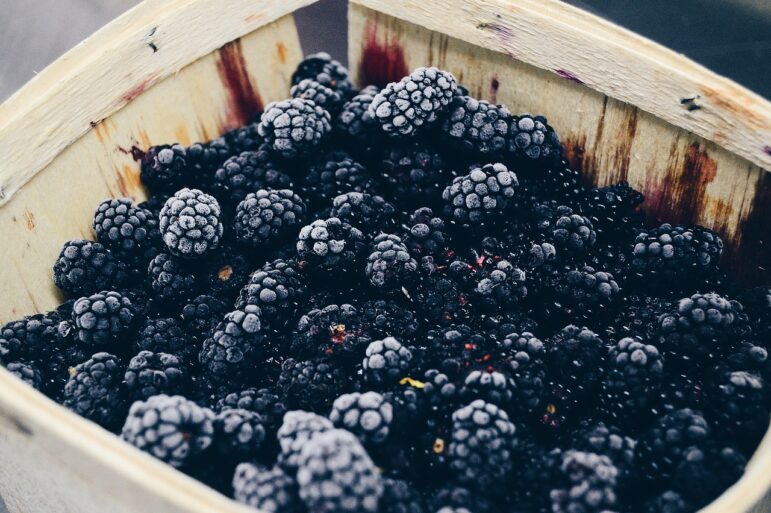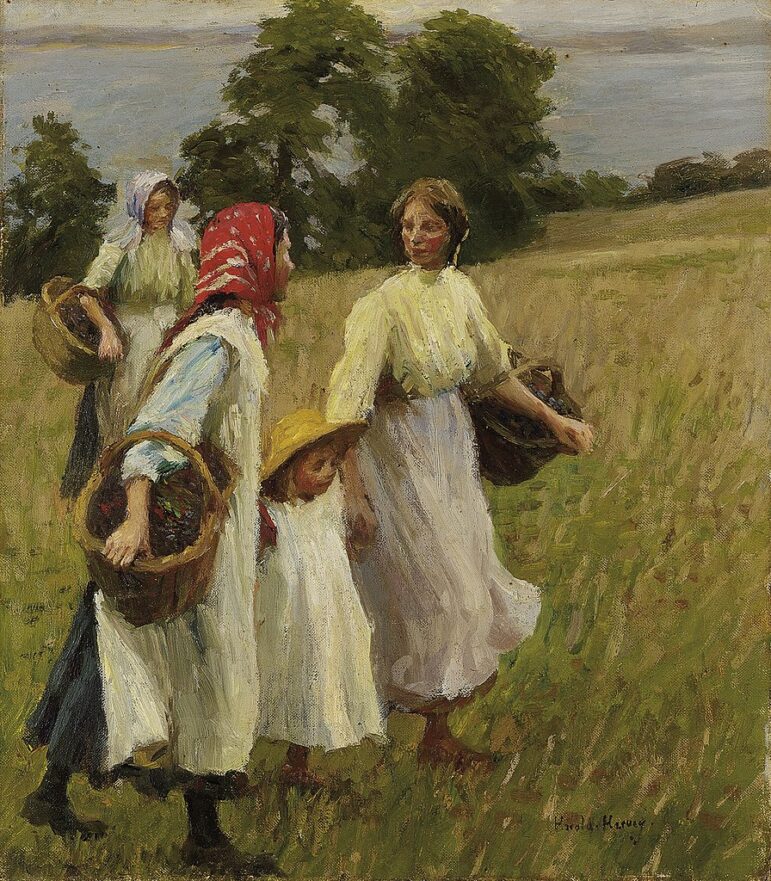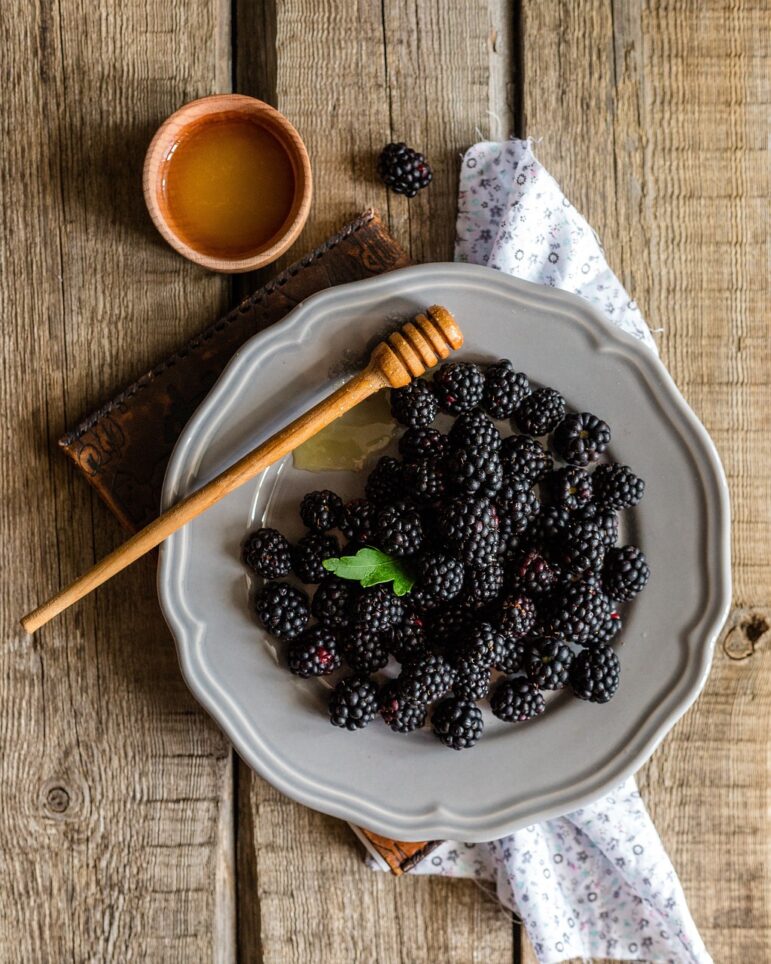
While it’s technically blackberry season until late October, you might want to have your crop harvested and tucked away a little earlier than that – at least according to the folklore of both Britain and Ireland, where a nasty supernatural surprise awaits those who ignore that advice.
The date for which blackberries become off limits, at least, to mortal hands, varies. So too does the creature responsible for rendering them unfit for human consumption, though its range of methods are remarkably consistent, and mostly involve the application of various bodily fluids and unclean body parts.

A basket of blackberries [Pexels]
In parts of Scotland, one of the earliest locations to suffer this fell visitation, on 29th September, the feast of Michaelmas, its the devil himself who is responsible, coming to vent his everlasting spleen against blackberry bushes just because one happened to interrupt his fall from heaven in a sharp, undignified sort of way. It’s unclear why he only does this once a year, or why they’re safe to eat before that, but I suppose the devil, like his adversary up above, moves in mysterious ways.
It’s not just Scotland where the devil takes the blame. Parts of England also attribute the befouling of the berries to the devil, and not just blackberries but other hedgefruits too. However as you travel south, the date of the devil’s arrival gets pushed back to the 10th October, Old St. Michaels Day, the date on which Michaelmas was celebrated before switching to the Gregorian calendar. This might simply mark a cultural difference in the response to the change, a reflection of the warmer southern climate extending blackberry season, or perhaps even a combination of the two. Blackberries are negatively impacted by the frost, turning mushy, and prone to rot and mildew afterward. They’re still there on the bramble just no longer desirable to eat, and of course that happens faster the further north you go.
For a people who had already noticed that blackberries were often inedible weeks before the Feast of St. Michael, being told that you’d actually been marking the wrong day, and that the devil’s visitation really took place eleven days earlier, would have made a lot of sense. Meanwhile for those living in warmer, southern climes, assuming that you’d got the day of his visit correct, and simply numbered it wrongly, was likely a more plausible explanation.
Alternatively it could be that it simply takes the devil a while to make his way down there. After all, the fastest a human being has ever traveled from John O’Groats to Lands End on foot was nine days, and while the devil is likely supernaturally fast, pausing to ruin every blackberry bush on the way is bound to slow him down a bit.
Despite this version of the story featuring the devil, and thereby taking place in a solidly Christian cosmology, it’s possible that this piece of folklore derives from an earlier, pre-Christian belief, one that was later assigned to the devil, and the nearest Christian festival, during and after the conversion process. It wouldn’t be the only such tradition; most religions pick up elements of other, earlier beliefs and practices when introduced to a new people group or region.
Sometimes it’s intentional, especially when associated with conquest and imperialism, Western Christianity and the pre-Christian Roman Empire were both experts at this, but it also comes about in a more organic fashion as people integrate their new belief system into their understanding of the world. The fact that blackberries frequently do become repulsive or even dangerous to eat around that time of year, and the existence of alternative versions of the myth featuring creatures that do not appear anywhere in the Bible, lends itself to the idea that this myth has its origins in something older.

Harold Harvey, “The Blackberry Harvest,” oil on canvas, 1941 [public domain, Wikimedia Commons]
In Ireland the dominant version of the story is that it’s the púca who comes and taints the blackberries, arriving on Samhain night or November 1st in the early morning to stake his claim. This later date makes sense climatologically as Ireland generally has milder winters and later frosts, thereby pushing back the date by which the blackberries will have been ruined by the changing weather. Samhain marks the end of the harvest season in Ireland, as Michaelmas and Old St. Michael’s Day do on the island next door; much of their cultural significance comes from their place in the agricultural calendar, marking the transition from one season to another.
It’s not a coincidence that certain food sources, both wild and domesticated, become off limits after this point, changing ownership from the human population to a supernatural Other, as this is when the world itself changes hands, transforming from a safe, or safer, domesticated place to one where the landscape turns hostile and wild spirits roam free.
The púca, alongside the bogle and other sinister fey spirits, can also be found in Scotland, competing with the devil to get to the blackberries first. An interesting difference between these two versions of the folktale is what ownership of the blackberries, and sundry other plants, means to the two classes of being.
For the devil, taking ownership of the plants means taking them away from humans. He doesn’t want to make use of them, he just wants to deprive humanity of a food source while exerting his own spite against a plant that had the misfortune of being between him and the ground. The fairy beings however, though they may well be malicious to humans, intend to make use of the berries. In Ireland, the Isle of Mann, and some parts of Scotland, the crops left in the fields beyond this point belong to the fairies, and to take them for yourself is to steal from Them – never a good idea.
Here we see here the difference between a binary cosmology, where one being exists solely to do and be evil with no nuance or complexity to his actions, and one built on shades of grey. Remember the Seelie and Unseelie aren’t actually separate courts or classes of beings, they’re the same individuals in different moods, with different attitudes towards humans. Some may lean more one way or the other but ultimately fairies exist along a spectrum just as humans do, and unlike the devil and his holy counterpart they live here alongside us – at least some of the time.
As is often the case with this column, there is a lot more folklore about blackberries, the beings that ruin them and what will happen should you eat them after the cut off date than I’ve been able to include here. A few parts of Scotland adhere to the Samhain date, just as some in Ireland hold with Michaelmas instead, meanwhile a minority in England believe it’s the end of August, and one village traditionally claims you should never eat them at all.
I encourage you to look into the blackberry folklore where you live now, and if you find anything interesting to let us know.

A bowl of blackberries [Daria-Yakovleva, Pixabay]
Blackberry and Apple Crumble
A recipe to use up the last blackberries of the season, this is something my grandfather used to make for us. He grew his own apples, and I think the blackberries were usually foraged from the massive forest of brambles growing on the cliffs by the sea, but if you’re limited to a grocery store (as I am now) the results will be just as good. This isn’t precisely his recipe – instead it’s one I’ve developed with my wife – but I think he’d approve.
Also he gets the credit for inadvertently suggesting the article topic by sternly reminding me not to use this recipe for another, apple-centric column I have coming up later in the year – after all, that column would be published after Michaelmas.
Ingredients
- 3 Bramley apples
- 150g (about 5 1/2 oz) blackberries
- 4 tablespoons of brown sugar
- 175g (3/4 cup) plain flour
- 110g (9 tbsp) caster sugar
- 110g (8 tbsp) salted butter
- 2 tablespoons of brown sugar
- 1 tsp cinnamon
- 1/2 tsp ground ginger
- 1/4 tsp nutmeg
- 1/2 tsp allspice
Preheat the oven at 190 C, or 170 C if you have a fan oven, and chill the butter in the fridge. Peel, core, and cut the apples into small cubes (about 1cm), place them in a heat proof baking dish with the blackberries, and then toss with 2 tablespoons of brown sugar.
Mix the flour, spices, and caster sugar together. Cube the butter and then, using your fingertips, rub it into the flour and sugar mix until you have something that resembles chunky breadcrumbs. Pour this over the fruit in the dish but don’t press it down because that will ruin the texture during baking and leave it too solid and heavy. Finally sprinkle the remaining 2 tablespoons of brown sugar over the top.
Bake for 35 minutes and allow it to cool for at least 10 before serving.
The Wild Hunt is not responsible for links to external content.
To join a conversation on this post:
Visit our The Wild Hunt subreddit! Point your favorite browser to https://www.reddit.com/r/The_Wild_Hunt_News/, then click “JOIN”. Make sure to click the bell, too, to be notified of new articles posted to our subreddit.